
Engaging
with the arts
Upper Valley schools offer students a variety of classes



Engaging
Upper Valley schools offer students a variety of classes

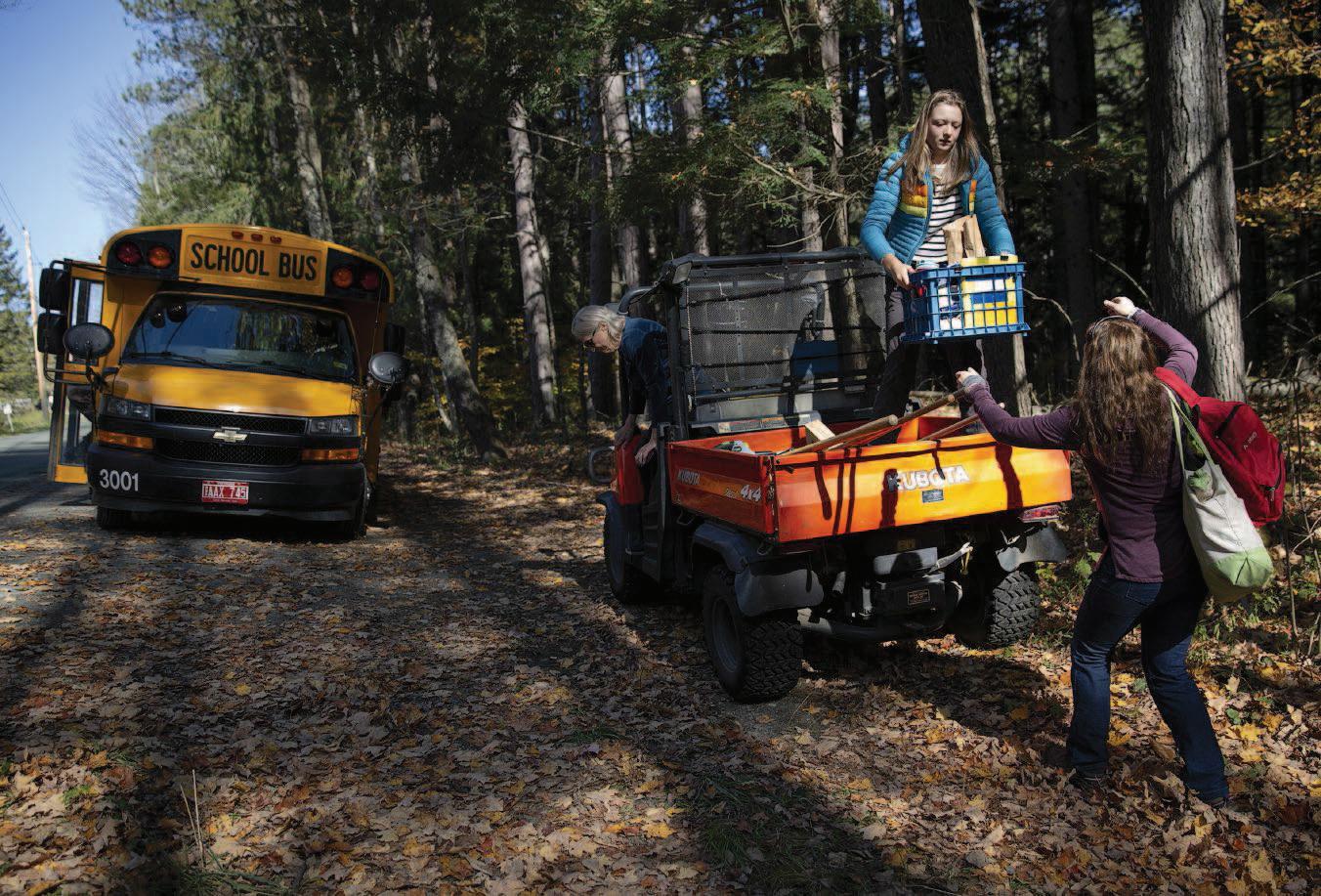
Excitement is high in the Claremont classrooms when first graders are treated to “Creation Stations”days, the plastic boards that got their name from what students build, from architecture, 3D sculptures to drawings.
A consistent participant in playgroups and a valuable member of The Family Place Advisory Committee offers his perspective as an Upper Valley father of a young child, which might resonate with other dads and male caregivers in our community.
: ON THE COVER Eighth grader Izzy Calsbeek, 13, uses a lathe to form a bowl made of resin during a shop class at Frances C. Richmond Middle School in Hanover last month.

Children’s, Women’s, Men’s & Juniors
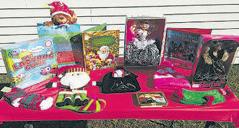
Shop here for Christmas Items
(Starting November 7th) Lots of brand-new clothes & toys with tags
Stop in for all your holiday shopping needs for the whole family

Hours: Thur-Sat 9-6 Sun 10-4
603-865-1898
5 Willis Avenue, Grantham, NH 03753 www.Closettreasuresnh.com





Community Arts Open Studio (CAOS)
Drop in for our Free Family Art Program! All art materials are provided—just bring your creativity and get ready to have fun.
Toddlers and Preschoolers: Fridays, 9:30-11:30 AM
For Families: Saturdays, 10 AM-1 PM
Winter Art Classes for All Ages
AVA offers a wide range of creative classes, including painting and drawing, woodworking and metalwork, pottery, and fiber arts.
Visit our website to Learn More!

22nd Annual
December 14 9am-4pm
Tracy Hall in Norwich

Join the festivities!
Gingerbread House Gallery & Auction
Learn about The Family Place!
Children’s Activities Country Store & Cafe
ADMISSION: $10 per family or $5 per individual

All proceeds from the event help The Family Place provide programs, resources, and support for families throughout the Upper Valley.

Gingerbread Festival Sponsors:











Children may watch ageappropriate shows, perform simple computer tasks, be offered food and complete surveys. We may also collect some saliva to research health-related genes.




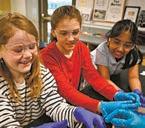



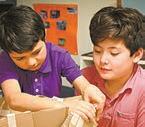










C OLUMN
Keep it simple and encourage them to have fun
By MIRIAM VORAN For the Valley News
Cooler weather is here and winter is on its way. Parents are looking for wholesome indoor activities to keep children busy and support their growing minds. Art projects usually top the list.
You imagine your child contentedly coloring, making a picture you’ll both enjoy. You’re not trying to nurture a Picasso. But you believe that art helps your child express creativity, gain mastery of the materials, practice flexibility and frustration tolerance, and —best of all —feel joy.
She gets to explore and experiment, to make something pleasing, and to see right there on her paper a picture reflecting her effort and inspiration, her own creation. Forget the coloring books and paint-bynumber. Forget the screen-based art apps. This is about your child getting the full-bodied, full-sensory experience of creating her own real art.
Or maybe this feels like a burden. Like most parents, you’re probably stretched thin. You probably already feel too responsible for your child’s growth. You might even wonder how to encourage your child’s art without setting expectations. You want to strike the right balance.
And you certainly don’t want the art tear-stained or torn to shreds.
It’s reassuring to remember that humans have evolved to create and to appreciate beauty.
We’re hard-wired for aesthetic pleasure: Frederick Turner, poet and literary scholar, describes “neurochar ms,”those harmonies in words, music, movement and images that we’re born to enjoy. The natural world shows endless beauty: the color and shape of a sunflower, the bold and intricate pattern of a peacock’s tail, the pleasing proportions of a conch shell. When we create art, we express something deep within, something that connects us to the natural world.
At its best, making art is the freedom to do what comes naturally. It is spontaneous and joyful. It is a deep
pleasure. And children, better than any adult, remind us of its delight.
My advice is: keep it simple. Have basic materials for your child’s creative use —crayons, markers, simple paints and lots of paper. For older children, you can add scissors and glue, construction paper, fabric scraps, anything colorful. Egg cartons, cardboard and pipe cleaners make great sculptures. And there’s always the play-dough you make from scratch.
When the materials stay basic, there’s lots of room to experiment. You don’t have to worry that supplies are too precious.
Emphasize the process. Resist the temptation to show what you can make with the egg-carton.
If they want your help drawing a horse or a tree, kindly and firmly remind them: “You get to draw it the way you want. I won’t put my marks on your paper. Then it wouldn’t be your picture.”
You might, in a child-appropriate way, remind them of Aristotle’s view: “The aim of art,”wrote the ancient Greek philosopher, “is to represent not the external appearance of things, but their inward significance.”Or, as Paul Klee (the Swissborn German artist) said, “one eye sees, the other feels.”
Once your child has finished the picture, you get to enjoy it together. You don’t have to hover and discuss every work as soon as she’s done. Let her come to you when she has something to share. Or, if that hasn’t happened, find a natural time —like the end of the day —to say you’re interested in seeing her pictures. I always find it helpful to reflect back the child’s effort: “Wow, you drew so much detail here. And over here, you added so many bright colors.”
And most important, I say how much I like to look at it.
Then, there’s the story the picture tells. I avoid direct questions, because they can come across as intrusive and demanding, too close to test questions, with the pressure to “answer right.”I’ll start with an invitation to tell me about the picture, and then show interest in the details. “And this here? You added something else.”
With an action-packed picture, it’s natural to say, “There’s a lot go-
ing on in this picture. I want to hear the story.”Sometimes I might explore further. “Oh, she looks so happy. Something made her happy.” Or, “oh, a big fight here! There’sa reason they’re fighting.”At times, I might even add a musing of my own, a trial balloon that doesn’t take over. “Did she take his favorite toy? But of course, it’s your story.”
I try to keep an open, curious stance, interested in the picture’s endless richness, and still respectful of the child’s privacy. Most important is that delicious experience of sufficiency, the satisfaction that we’ve talked enough, without my always pushing for more. Children enjoy the gift of easy hanging out, relaxed enjoyment of their art, open space if they want to add a thought. Remember, we’re also hard-wired to connect, to share understanding. We probably all over-do it at times, forgetting to trust that connections happen naturally. With my suggestions here, I’ve tried to keep things simple and fun as you support your child making art. If you feel overburdened, take this advice with a grain of salt. Every family finds their own way. Most important, you and your child have a rich opportunity. You get to share one of the deepest human pleasures —the enjoyment of beauty and creativity. It becomes a year-round, and life-long, pleasure. Miriam Voran consults with parents and practices psychoanalytic psychotherapy with children and adults in West Lebanon and Montpelier. She is a Clinical Assistant Professor of Psychiatry at Geisel School of Medicine at Dartmouth. She lives in West Lebanon.
PBS Kids. Parent Resources for the Arts. This website gives age-byage tips and activities for enjoying the arts with children ages 2-8. https://www.pbs.org/parents/ lear n-grow/all-ages/arts National Association for the Education of Young Children. “Supporting the Development of Creativity.” This blog describes the difference between process and product art. Plus, you’ll find other useful resources at: naeyc.org/our-work/families/supporting-development-creativity.

Young adults who had mentors:
Are more likely to report engaging in productive and beneficial activities than youth without a mentor.
Have more positive visions of themselves and their futures and achieve more positive outcomes in school, the workplace, and their communities.
Report setting higher educational goals and were more likely to graduate from high school and even go on to college.
We love WCM! Our daughter struggled with peer interactions, but having a mentor through WCM has helped her to come out of her shell and open up to others. She is thriving and happy to have someone who is always there for just her, and is happy to listen and help with any situations and feelings she may need guidance in.

"WHEN ASKED BY MEMBERS OF THE COMMUNITY HOW THEY CAN HAVE AN IMPACT ON THE SAFETY, HEALTH, AND VIBRANCY OF THEIR COMMUNITIES, MY NUMBER ONE ANSWER WAS ALWAYS: MENTOR A YOUNG PERSON.”
Michael Schirling, retired chief of the Burlington Police Department and 2016 Mentoring Month spokesperson for Vermont





Specializing in all aspects of family eye care:
Comprehensive medical eye examinations
Contact lens specialists
Infant & children’s evaluations
Pre- and post-laser surgery services
Largest optical showroom in the area
Eyeglass accessories
Designer & sport sunglasses
Medicare and Major Medical Accepted


Evening Appointments Available Locations in
Evening appointments available at the White River location.
Dr. Eugene J. Bernal • Dr. Heather Bourdeau Dr. Sandra K. Dufour • Dr. Ran He
White River Junction, VT
Dr. Jessica Berry • Dr. Mitchell Styczynski

Hanover Eyecare 45 Lyme Rd. Suite 201 Hanover, NH 03755
603-643-2140 • Whiteriverfamilyeyecare.com
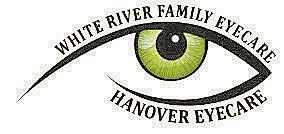

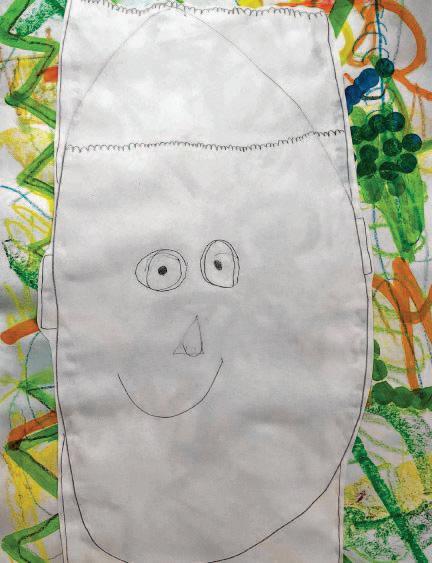

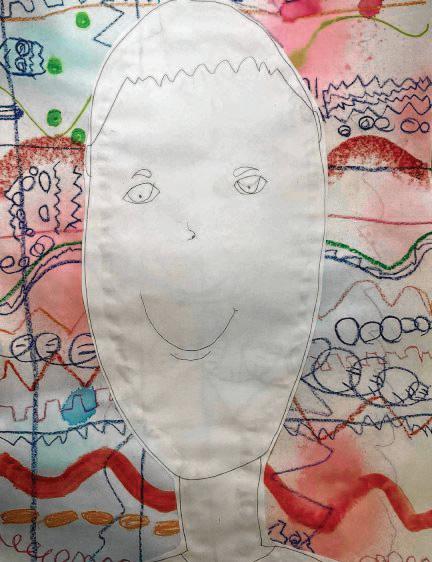
By PATRICK O’GR ADY Valley News Correspondent
CLAREMONT —Itwas “Creation Station”day in Sue Tuttle’s art classat MapleAvenueElementary School and the excitement in the room was high.
Seated around several tables, the 14 first gradersfrom Julie VanInwagen’sclasslistened patientlyasTuttle identified the materials at each of theirtables, setoutthe fewrules they ’d have to followwhile they let their imaginations loose.
Play-Doh, Lego sets,tile magnets for making small structures, geoboards —plastic boards with pegsand stretchbandsto makedifferent shapes —and interlocking plastic pieces shapedlike plus signs were allup for grabs onthe tables. Creation Stations got their name from whatstudents build,from architecture, 3Dsculptures todrawings.
One studentparticularly interestedin theLegotable wasAlexys Davis, who carefully built the walls of her structure.
“I reallylike tobuild things,”
Alexys said. “You can see I am building right now and you can see I really like to do it. That is my favorite thing to do.”
At the tile magnet table, Enzo Bovell was proud of his one-bedroom house. Beside him, Jaxson Ellison made 3Dshapes of apyramid, cube andsquare. Otherstudentsused magnets to constructmore elaborate buildings with rooms and angled roof tops.
Tuttle encouraged the children to experimentwith thedifferentmediums. Shefrequently encouragedand praisedfortheir effortsasshe moved around the room.
“At the elementary level we mainly focuson thecreation ofart because wefeel thesefoundational skills are really important with young kids,”Tuttle said.
Tuttleteaches childreningrades kindergarten through fifth. With her the youngest students,she works on developing their fine motor skills throughcoloring, cuttinganddrawing.
Inallofher classes,shetriesto incorporate choice as much as possible becauseit encouragescreativity,
saidTuttle,who hasbeenwiththe Claremont School Districtfor 20 years. For the Creation Station activities, she had her room set up so students could move freely among the tables depending on their interests.
Brayan Bartley found his “Creation Station”atthe drawing table where he used markers to sketch a house anda schoolwith rainclouds overhead and vehiclesparked in front.
“Ireallylike todrawusingmarkers,”saidBrayan, whospenttheentireclass atthedrawing table.“At home, I have my own drawing kit.”
In other academicclasses, the subject matter ismore teacher-directed and there is a right way to get toan answer,Tuttlesaid. That’s different in art classes.
“Here, there are a million ways to get there,”she added.
Thedistrict followstheNational Core ArtStandards. Tuttlespends moretime directingkindergarten, first and secondgrade students to help thembuild theirfine motor skills.
Students in grades three and above tend to have a good foundation
alreadyanddonot needasmuchinstruction, so they have more choices in what they want to make.
“Itisnotme tellingthemwhatto create. They haveto plan ahead,” Tuttle said.“I’m puttingmore ofthe thinking on them becausethis is one of the safest places for them to make a mistake and learn how to create and solve a problem.”
Using materialssafely andresponsiblyandcoming upwithan idea andfollowing it throughto completionaresome ofthebenchmarks at the elementarylevel for competency.Some mayneedassistance while others cancomplete the work independently, Tuttle said.
Another piece toTuttle’s art instructionis sharingthechildren’s work through an app called Artsonia. She can take picturesof each child’s workwith theappandemail itto their families.
“I can have it all digitized and can puttheirportfolio onlineforfamilies to see anywhere they are,”Tuttle said.
Patrick O’Gradycan bereached at pogclmt@gmail.com.
Tel:603-448-0030www.facebook.com/eyeglassoutlet

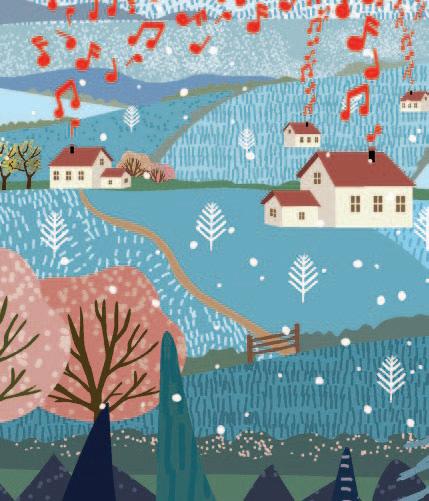

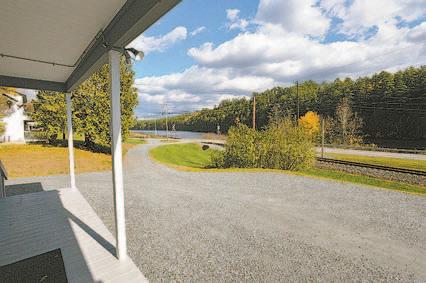
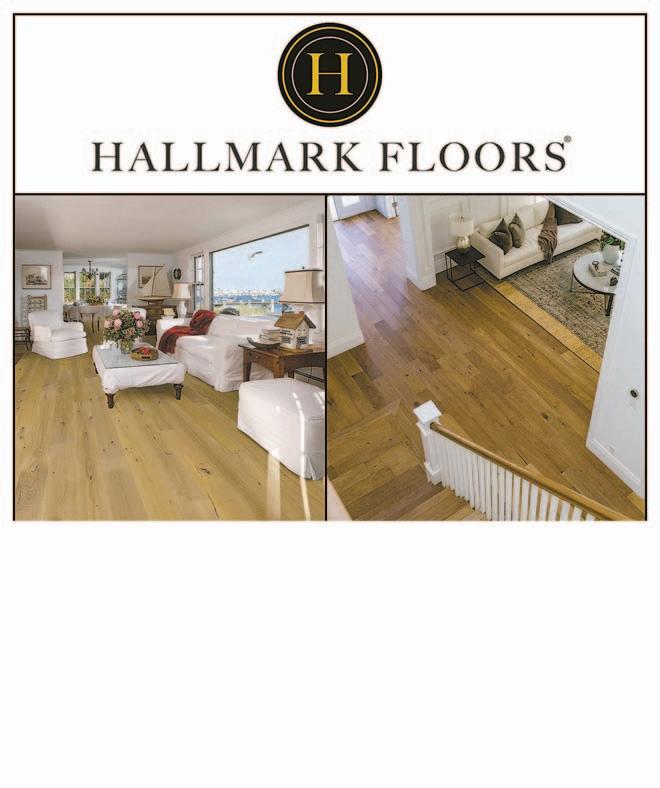



‘Something that is beautiful and functional’

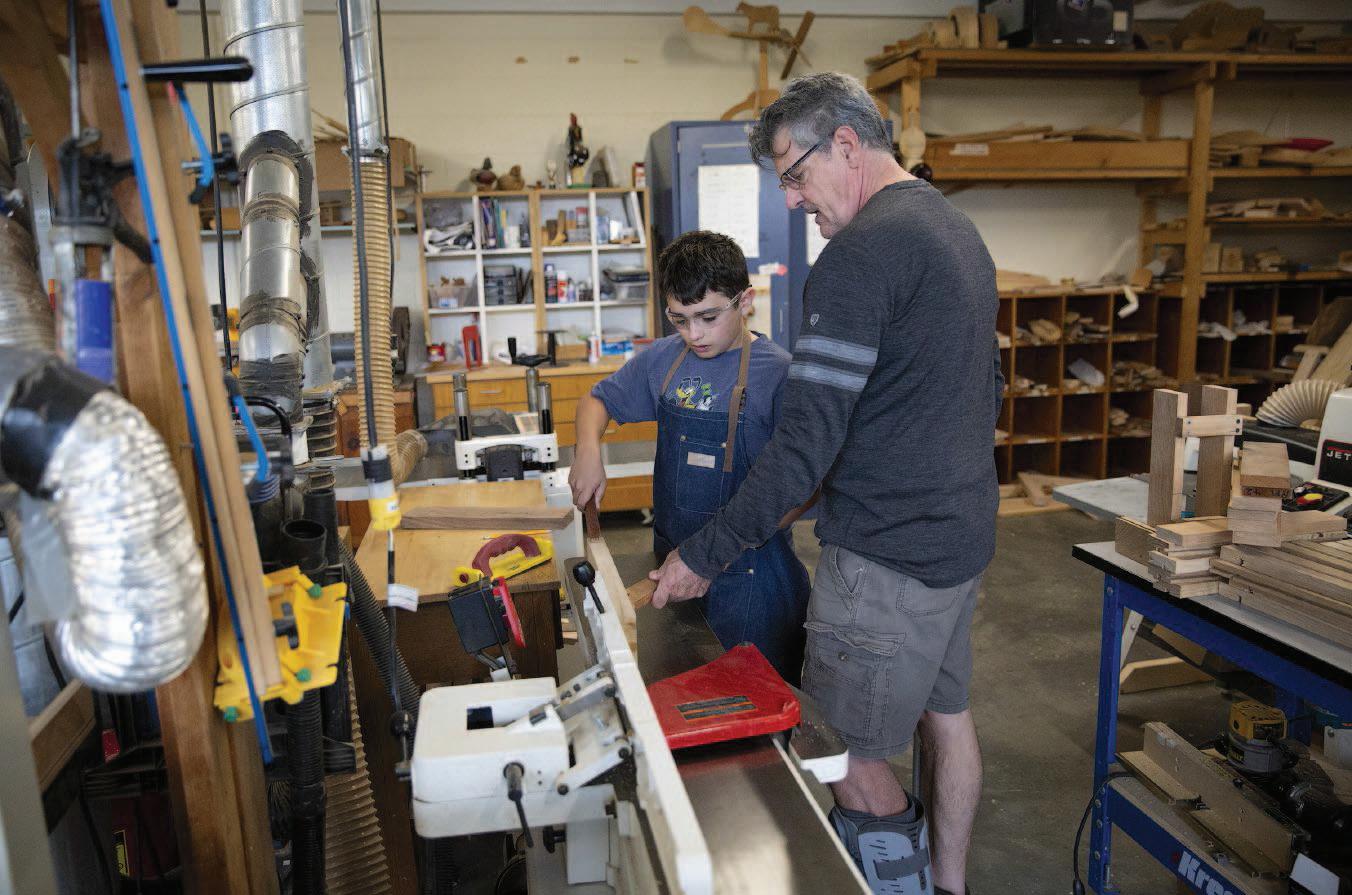
By PATRICK O’GR ADY Valley News Correspondent
HANOVER —Besides crafting something useful fromwood, eighth graderGabriel Lizcanohadanother reasonfor takingCliffHarriman’s woodworking class at Richmond MiddleSchool:the joyhiswork brings others.
“It isnice afteryou workso hard onsomething thenseeing thefinal product and giving it to someone else and seeing themreally happy with it,”Gabriel said while working on the topof atableofblack walnutand maple he is making for his mother. “I gavemy firstcuttingboard tomy grandmother forour littlesummer homeinMaineand sheloveditso
much and that made me happy.”
Har riman’s morning woodworkingclassfor 12seventhandeighth gradersisa typicalwoodshopscene with the din of sanders and other machines. There’salso aprevailing scentofwood, comingfromlumber everywhere. Shelves packed with finished work includedchess boards andcuttingboards. Allaroundthe room, students arefocused on projects in various stages of completion.
Seventhgrader ZoeyJenneygently sanded the backside of her woodenspoon withanoscillating spindlesanderto gettheproper shape under the watchfuleye of substitute teacher Tim Sullivan. Art teacher Sara
SEE WOODWORKING S11


“I just like woodworking and making stuff,”Zoey saidabout why she took theelective course. “I’malso a very artsy person.”
Harriman, who returned to Richmondin mid-Octoberafterankle surgery,took overthe programfour years ago,after longtimeteacher RichardStarr, whoreliedprimarily on hand tools for instruction, retired after 40 years with the district.
Harrimanadded newequipment, includingjigsaws, ajointer, atable saw,sanders andlathes forwood tur ning.
“So itis acombination ofclassic woodworkingas wellas turning(on lathes),”Harriman said.
Alot ofwoodturning,which isnot commonin schoolwoodworking classes, and the move to more furniture building including tables and chairs is what makes the course unique, Harriman said as he scrolled throughphotoson hisphoneof chairs andShaker tablesmade by students last year..
Tostart, allstudentsmake wooden spoons of various sizes becausetheyare simpleandeasyto make beforemoving ontomore challenging projects.
“Normallytheygo throughadesign process,”Harriman said. That includessketching outdimensions, deciding what type of wood to use and compiling a materials list.
“The wholegoal is for thekids to make something that is beautiful and functional,”Harriman said.
Visualarts atRichmond areelective courses except for a required semesterinsixth grade. SaraEllis teachesallthree grades.includinga class called Paint onCanvas. In her class last month, several students wereworkingon theirblackand white paintings for the course.
Students begin working in black andwhiteduring thefirstsemester beforemoving ontocolor andcolor theory.Their year-endassignmentis tocompletea colorpainting.Those who committo Painton Canvasare hopingto getintoa HanoverHigh School design class, a prerequisite forall otherhighschool artclasses, Ellis said.
“Mythought istoget themexposed to a bunch of different art making mediums,”Ellis said. “Some may like painting butnot drawing while otherslike drawingbut notsculpture.
Ellis also teachesceramics, jewelry making, sketchingand watercolor classes.
Thefreedom ofcreativeexpres-

sion to develop her own ideas is why eighth graderScarlett Addante-Holstrom takes art classes
“I feellike youhave alot offreedom withart ingeneral. Youare given a project but you are allowed to add your own touch and be more creative,”Scarlett said while carefully painting white lines on her painting of a zebra head and neck.
Shehasalso foundartisticfreedominceramics, sketchingandwater colors.
“I reallyliked ceramicsbecause you definitelycould dowhat you wanted and I made a really big bowl,” Scarlettsaid. “Itwas veryselfguided.”
Nearby,eighth graderEvelyn Swanwick used different shades of black pencilsto sketch a modelof a small wooden stick figure.
“I’m using differentshades to make it look more realistic,”Evelyn said, adding that she enjoyed a previousproject ofcolor sunflowersand looked forward to taking a sculpture class.
Elliswants herstudents tohave fun in class as she introduces them todifferent artforms butalso togive their best effort.

Eighthgrader
“Somekidsare highfliers,”she
said. “For others it can be hard, but aslong astheyaretrying todotheir best, it is more about the process and
howto usethingssothey cantakeit and make it what they want.”
Back at thewoodshop, eighth grader Izzy Calsbeek, took a break fromusing achiselandmallet tobegindiggingout thebowlportionof herspoon andfocused herattention to turningon a latheto workon her wood turning skills. Izzy locked into the lathe a bowl she made last year of resin with pine cones embedded in it. She then slowly moved a carbide scraper alongthe inside edgeof the bowl to shave away the interior.
“Itis reallyfuntosee howdifferent thingsare made,”Izzysaid. “I madeanother bowl,a spoon,candlestick holders andalso have done wood burning.”
With enrollmentlimited, Harriman said he hasarranged to open theshop ahalf-hourearly forkids whocould notsign upfor theregular class period.Some will comein four or five days a week.
“It’s extratime for me,but the kids that come in, like those that sign upforregular classes,wanttobe here andwant to makegreat things for themselvesand/or familymembers,”Harriman said.
Patrick O’Gradycan bereached at pogclmt@gmail.com. WOODWORKING FROM S10

By LORI STEVER For the Valley News
Becoming a parent is a wonderful and unique experience. There is nothing quite like the love and joy that a child brings to a family.
As a mother of three, I remember the joy and excitement that came along with each birth, as well as the new challenges that I faced.
I grew up in the times when my grandparents lived within miles of us, when Saturday trash runs with my Dad were a regular occurrence and our cousins were our best friends. (I know, I’m aging myself!) In turn, when I was raising my children, life had become much more mobile, families relocated for jobs and opportunities, technology started to become a part of everyday life. Supports for families, traditionally for moms, meant reaching out beyond family to the community and creating your own community of peers and supports.
This past year when I started my new role at The Family Place as a parent education coordinator — and became a grandmother for the first time —I started taking note of recent trends and traditions. One of the most significant observations is how the services and supports for dads and other male caregivers differ from those available to women.
In partnership with other Upper Valley nonprofit organizations (including the Montshire Museum of Science, Hartland Library, and Way Point) The Family Place hosts playgroups for families with young children at a variety of locations throughout the Upper Valley.
Playgroups offer socialization for both parents and children, along with occasional education and training. In response to this service need and the outreach success of playgroups, The Family Place recently launched a Male Caregivers Playgroup on Saturday mornings on our Norwich campus.
Robert “Bob”Pyer has been a consistent participant in our playgroups and a valuable member of our Family Advisory Committee. I thought his perspective as an Upper Valley father of a young child might resonate with other dads and male caregivers in our community.
Question: So Bob, my first question is pretty straightforward in regards to your family —how many of you are there and what ages?
Answer: So currently there’s three people in my family. Robert Pyer or Bob, and I’m 40. Larissa Pyer, my wife, is 38. And then we have a 2½ year old son, Ross Pyer.
Q: And anything, maybe something else going on?
A : So in two months time, we’ll have a, what do you call them? A zero? A newborn, Kasia Pyer.
Q: Can you talk about one thing or more that’s really important to your family?
A : Understanding each other through communica-

tion. Spending the extra time watching our reactions, especially when we’re trying to help our son learn all of his new emotions.
Q: What are some things that you and your family enjoy doing together?
A : Getting outside, hiking …leaving the house and going off in the woods or just being outside and coming up with our own curriculum. Instead of sitting inside and saying our ABCs, we’re going to go outside and find, you know, an apple and learn about it.
Q: Is community connection important to you? How do you work that in?
A : Absolutely, whether it’s the three of us, or just me and Ross, we go to a bunch of different things. We’re in the community, trying to make connections. Usually though you’ll find I’m the only male that is on the playground or in a playgroup setting.
Q: Can you share a proud moment about your family?
A : Two weeks prior to when I was planning to go back to work, we finally realized that we wanted to have me at home taking care of our child. It was really me —and my wife, of course —looking at each other and being able to verbally say what our goals are going to be throughout this, how we’re going to accomplish this, acknowledging that yes, it’s a group effort, but really, it’s going to be my role to make sure everything works out correctly. With our son, even though he was only 5 months old, we could talk to him and he couldn’t speak back, but I could definitely tell that he would react to my emotions. I let him know that this is going to be an effort on your part too. I think he’s starting to understand that part better now.
Q: Before you made the decision to become a stay-at-home parent, what was your plan for child care?
A : We did have child care lined up, at a facility that was 100 feet behind where I was working. It would have worked out well for us and there was really no other option because of COVID. We had our deposit in, we were ready to go, and then they ended up shutting down.
Two weeks after we put our deposit down, we got the notification that they would be returning our money and the new place coming in wasn’t going to take newborns at all.
Q: How would you feel you view your role as a male caregiver and how is it different from your partner ’s role in your family structure?
A : It’s a very team-oriented household. When Larissa comes home at night, she’s helping out. She
went to her job during the day and did her best. I stayed home and I did my best with Ross. But that doesn’t mean that my job is 24/7.
She’ll come home, maybe she’ll help cook dinner with him, and then she’ll play with him. And then she’ll go ahead and, you know, want to help me put him to bed. Some of that is mom guilt, and there is some natural dad guilt too.
I get questioned all the time: “Oh, does that mean that you clean the house? Does that mean you do the dishes?”Well, do you know what a woman who’s a stay-at-home parent does? Okay, well, that’s what I do. The job doesn’t change just because I’m a man. We’ve actually stopped saying “stay-at-home dad,”because I don’t just stay at home with my kid. We’re always out in the community doing things.
Q: Why is it important to you to participate in activities like playgroups with your son?
A : Ross has been an only child, so I wanted to make sure he had more interaction. When we started going, It gave me a chance to get out and do something fun with other families too. My son was just under 2 years old, and I was still in the trenches of not going out much, not doing a whole lot for myself. Through activities like this, I’ve heard a lot of different perspectives from people and what they’re going through. These are people that I never would have been able to connect with otherwise.
Q: What do you gain from your connections with other male caregivers?
A : I like to hear how they did something with their child, what they ’ve tried. Learning what other people have gone through helps me embrace change more. It’s great talking to other fathers and hearing they did something the same way or they did something a little different. It’s great being able to have that connection with them.
Q: What advice do you have for parents and caregivers raising young children in our community?
A : In the Upper Valley, my experience compared to my wife’s is like a whole other world. Everything happens during the day. And for me it was like a whole other world that was out there to support us. You have to just get out and do things and have trust in other people who are involved in things like playgroups. That means letting yourself be open to other people’s perspective on things and doing things maybe you wouldn’t normally do.
Bob Pyer is the chair of The Family Place’s Family Advisory Committee. Lori Stever is the parent education coordinator at The Family Place.








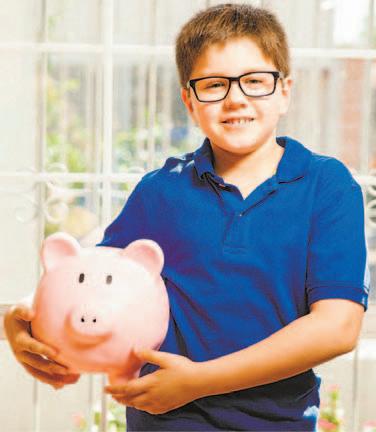


‘Improving our relationship with the natural world’
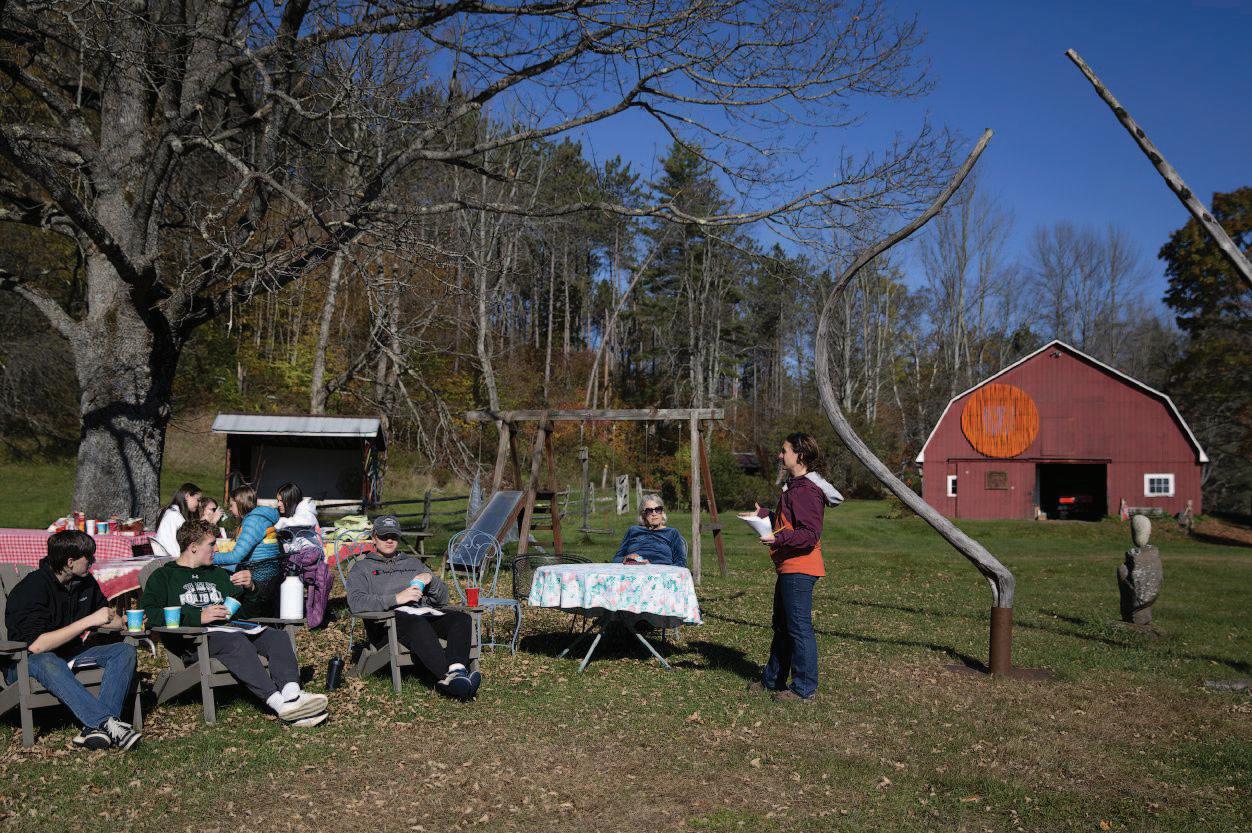
By PATRICK O’GR ADY Valley News Correspondent
WOODSTOCK —Ona warm, early fall morning students in Katrina Jimerson’sEco Artclass at WoodstockUnion HighSchool prepared for a “scavenger hunt” atSculptureFest, anartexhibition on farmland in Woodstock.
The 15 students were in search of sculptural principles including lightand shadows,texture,negative and positive space. They were also lookingfor theways artists use land as a canvas and for materialsthatconnect arttothenatural world.
Sophomore MacKenzie Graham said creatingart that ex-
plores thoseconnections iswhat drew her to the class.
“I love art and I love nature and this combination inone class sounded perfect,”Graham said during the activity,adding that having Jimerson as the teacher was anotherreason totake Eco Art.
Graham andjunior Schulyer Haggesaid theyhaveenjoyed learning how to make paints from natural ingredients, including flowers and berries.
“I’mgoing tobetaking APart nextyear andIam interestedin creating my ownpaints for my portfolioand workingin anatural medium so Ms.Jimerson thought it would be a good fit for me to
start my portfolio and gather the materials I’ll needfor nextyear,” Hagge said.
As anart studentand latera teacher, Jimersonhas longheld aninterest inexploring theinterplay betweenart andthe natural world.
“Since then I have had different variations of this class and others whereI made thefocus on finding waysto getstudents outside and connect with nature,” Jimerson said during the field trip to Sculpture Fest.
Duringher 20years asa teacher —including 19 at Woodstock —Jimersonhas taught classes titled green art, art scienceand theenvironment andart
and the landscape. She has led the eco art class for three years.
“The overarching objective of ‘Eco Art’is to haveeach student investigatethe multipledimensions, systemsand relationships oftheir ‘place,’ ”Jimerson said later in an email.
That includes understanding food and forest systems, as well as sustainability practices. She wants her studentsto reconsider the relationship between humans and nature—and howthey can evolve in the future.
“EcoArt isaboutimproving our relationship with the natural world,”Jimerson wrote.“Much of

theartis collaborative—involving input from artists, scientists, and members of the community.”
Thissemester, theEcoArtclass isengaged in a study of sculpture as it relates to the natural world. The class has taken a few field tripsto SculptureFest, whereartists display their workon the land ofPeter and Charlotte Davenport.Sculptures ofdifferent shapes,sizes and materialsdot the grassy hillsideand can be seenon other parts of the property.
“We started a tradition of having the EcoArtclass participateinthisamazing thing called Sculpture Fest,”Jimerson told her students soon after they arrived. “It is a uniqueand special opportunity as you learn what SculptureFest is and you willhave theopportunity tomeet someof these artists.”
Jimerson saidit isher students’first introduction to sculpture and “thinking about sculpture in place.”
Eco Artis one example ofwhat Jimerson believes is a change taking place in traditional high school art classes.
“We focuson learningwith nontraditional art media,”Jimerson wrote in an email. “Weuse natureas aclassroom, canvas, materialand inspiration,and weare collaboratingandlearning fromartistsin the community.”
One ofthose artistsis LelaJaacks, a Brownsville residentand 1995Woodstock High School graduate,who discussed two of herworks with studentsduring their field trip to sketch some of what they see and look for differentartistic elements of the sculptures. Jaacks discussed two of her works that were on display.
Oneistitled “Fairy Ring,”which Jaacks saidis “inasense, anabstractionof acluster of mushrooms.”
“My workis notdirectly afull representationof whatI seeinnature,”Jaacks explained to the students. “I’m distilling it and looking at the patterns of how light forms.”
The group movedonto Jaack’s second work, “Pause III,”which features shells and naturalartifacts embeddedin small panels ofcast concretesecured toposts along the driveway.
“I love the idea of zooming in or zooming out. So that piece hasthat quality for me; what would it be like to interact with a cluster of mushrooms,”she said. “That is a fun way to observe nature for me.”
Asthestudents preparetocreatetheir own sculpture later in the semester, Jaacks told them to remember that everyone brings theirown perspectiveto sculptural works.
“Whenyou arecreatinga sculpturethat is site-specific, take into consideration your environment, what is around you,”she said. “What is themessage or what areyou hop-

Above: Junior SchuylerHagge, left, works on a sculpture with the help of art teacher KatrinaJimerson inWoodstock last month.Right: Fromleft, senior Caeden Perreault, juniorRowan Larmie and senior Micah Audsley drive a branch into the ground as they work on a sculpture.
ing the viewer gets out of the piece you are creating, whether it is just an expression of yourselfor whether it isa conversation with the environment you are in.”
Thestudents —sophomores, juniors andseniors —seated undera largetree with leaves just beginning their turn to fall colors, heardCharlet Davenportspeak about the history and mission of Sculpture Fest. Shealso highlighted someof the works on her Woodstock property.
Eco Art works can be site specific while others areephemeral, whichmeans they changeor disappearas theenvironment changes.
“There are a lot of beautiful ways the artists are workingwith the landscape here,”Jimerson toldherstudents asthey explored Sculpture Fest.
Sophomore Ana Salisbury said she is takingthe classbecause ofalove ofart andhopestoone daybeaprofessional artist.Eco Art,she said,isanother typeof art she wants to add to her skill set.
“Ilove theidea ofexpanding mymediums,”Salisbury said.
Patrick O’Gradycan bereached at pogclmt@gmail.com.

Healthcare for your children, and the whole family is here at Valley Regional Hospital. Preventative medicine including immunizations is critical to your child’s health. Our providers support the growth and wellness of your newborn and they care for patients up to age 18. If you have been looking for a compassionate and skilled pediatric team to support the needs of your growing family, contact us!
Corinne Sullivan, MD
Juliann Barrett, DO
Victoria Johnson, MSN, CPNP-PC, SANE
Marcella Meier, MSN, FNP-C
Shannan Metzger, MSN, MPH, APRN, FNP-C
Valley Regional Hospital – WE CARE about your children! Schedule an appointment by calling 603-542-6700 today.

Valley Regional Hospital has been caring for the greater Claremont community since 1893.